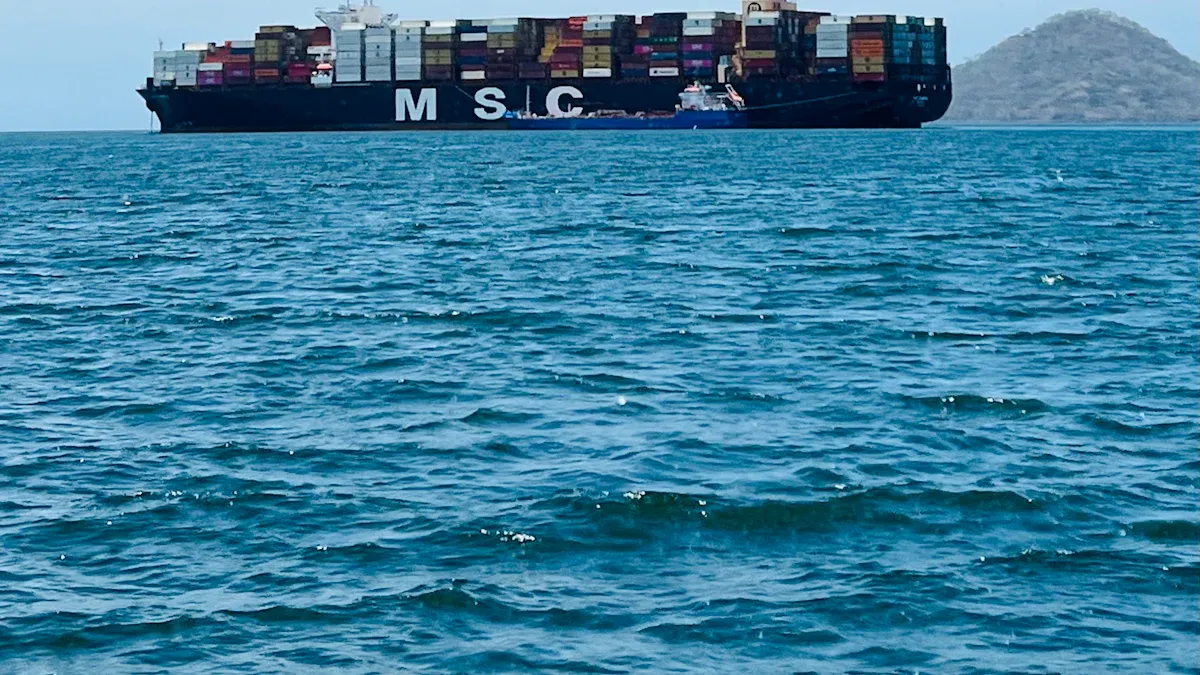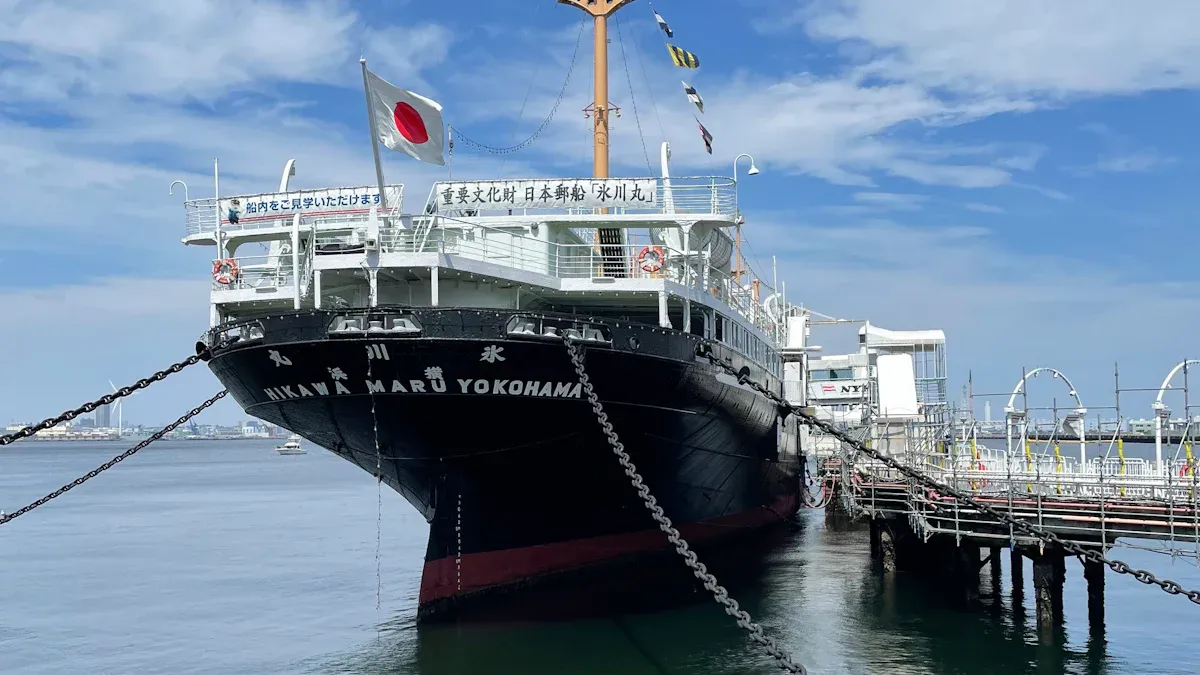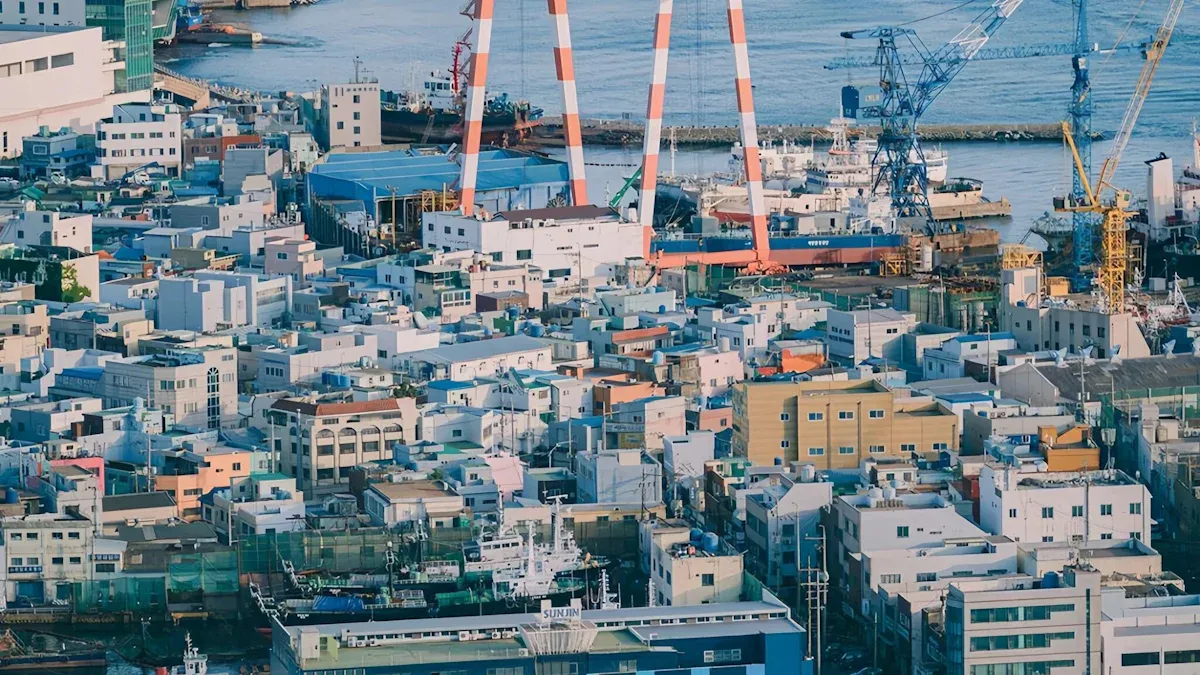Emerging Trends in Japan's Ocean Freight Market 2025

Japan’s ocean freight market in Japan plays a crucial role in connecting the nation to global trade networks. As an island nation, Japan relies heavily on maritime transport for its economic growth.
Nearly 90% of the country’s trade moves through sea freight.
The ocean freight market in Japan dominates the logistics industry, supporting imports and exports that fuel its economy.
Its strategic location in Asia-Pacific enhances its ability to facilitate international trade.
Understanding these dynamics helps you see why maritime shipping remains vital for Japan’s prosperity.
Key Takeaways
Japan's ocean shipping is important, as 90% of trade uses ships.
New technology like AI and robots makes shipping faster and cheaper.
Being eco-friendly is key; companies must follow rules and look good.
Trade deals create new markets, helping businesses grow and change suppliers.
Knowing world events helps businesses adjust and find new chances.
Current State of the Ocean Freight Market in Japan
Japan's Position in Global Shipping and Trade
Japan holds a significant place in global shipping. Its ports connect Asia-Pacific trade routes to the rest of the world. Tokyo, one of Japan's busiest ports, ranks 41st globally, handling 4.57 million TEUs (twenty-foot equivalent units) annually.Japan also excels in international trade. It exports over 4,000 products to 214 countries, with total exports valued at $746.7 billion.
This robust trade network highlights Japan's critical role in global commerce.
Key Developments in the Market Over Recent Years
The ocean freight market in Japan has experienced steady growth. In 2024, the market size reached $322 billion, with projections estimating $415 billion by 2033. This growth reflects a 2.9% annual increase. Several factors contribute to this trend:
Japan's e-commerce market is expected to hit $667.4 billion by 2032.
Transportation infrastructure construction is growing at a 4.9% annual rate.
Green technology and sustainability initiatives are gaining traction, with a market size projected at $43.42 billion by 2032.
These developments indicate a shift toward modernization and sustainability in Japan's shipping industry.
Long-term Impacts of the COVID-19 Pandemic on Shipping
The COVID-19 pandemic reshaped global shipping dynamics, and Japan was no exception. Freight costs fluctuated significantly, creating long-term challenges for shipping rates. Vessel shortages and logistical inefficiencies slowed trade flows, driving up costs.
Demand for goods surged during economic recoveries, especially in China.
Shortages of vessels disrupted trade, increasing shipping costs.
Logistical inefficiencies persisted, affecting supply chain reliability.
Despite these challenges, recovery is underway. Historical patterns suggest that freight markets recover six to twelve months after economic adjustments, such as Federal Reserve rate cuts. Government incentives and sector-specific recoveries in industries like automotive and electronics are expected to boost freight demand further.
Emerging Trends in Japan's Ocean Freight Market 2025

Technological Advancements Driving Efficiency and Innovation
Technology is transforming the ocean freight market in Japan, making operations faster, smarter, and more efficient. You can already see how automation, artificial intelligence (AI), and real-time tracking are reshaping the industry. For example:
Route Optimization: Tools that use traffic and weather data help ships avoid delays and reduce fuel consumption.
AI and Machine Learning: These technologies analyze past data to predict demand and costs, helping businesses make better decisions.
Real-time Tracking: Modern systems let you monitor shipments, improving transparency and identifying bottlenecks.
Automation is also playing a key role. Warehouses now use automated systems to speed up cargo handling and reduce errors. This not only saves time but also lowers costs. Companies like Maersk have shown how AI can cut fuel use by 12%, proving that technology can boost both efficiency and sustainability.
Japan is also exploring autonomous shipping. Rolls-Royce’s Intelligent Awareness system, already in use on over 200 vessels, shows that unmanned ships are no longer just a concept. These advancements are setting the stage for a more innovative and competitive ocean freight market in Japan.
Sustainability Initiatives and Green Shipping Practices
Sustainability is becoming a top priority in the shipping industry. Japan is aligning with global goals like the International Maritime Organization’s (IMO) target of zero emissions by 2050. By 2025, new regulations will require ships over 5,000 gross tons to cut greenhouse gas emissions by 2%.
Regulation | Description | Timeline |
|---|---|---|
Zero by 2050 Goal | Adoption of a target for zero emissions in shipping | Target set |
Fit for 55 Package | Ships must reduce GHG emissions by 2% | By 2025 |
EU Emissions Trading | Ships must purchase emissions allowances | Phased in |
Japan’s shipping companies are already taking action. NYK Line plans to launch an ammonia-fueled bulker by 2026, supported by government funding. This reflects a broader trend toward alternative fuels, with projections suggesting that 15% of the global fleet will use zero-carbon fuels by 2030.
Green technologies are also gaining momentum. The logistics green tech market is growing at a 24% annual rate, highlighting the urgency for businesses to adopt sustainable practices. By embracing these changes, you can not only comply with regulations but also gain a competitive edge in the market.
Geopolitical Influences on Trade Routes and Freight Rates
Geopolitical events are reshaping trade routes and impacting freight rates in the Asia-Pacific region. For instance, U.S.-China trade tensions are prompting companies to shift operations to other Asian countries. This shift is creating new trade routes and diversifying supply chains.
Fluctuations in oil prices, often driven by geopolitical risks, directly affect freight rates. When oil prices rise, shipping costs increase, putting pressure on businesses. You might also notice how proposed tariffs on key trading partners create uncertainty, forcing companies to rethink their strategies.
These changes present both challenges and opportunities. By staying informed about geopolitical trends, you can adapt your operations to minimize risks and capitalize on new trade opportunities. Diversifying supply chains and exploring alternative routes can help you navigate this evolving landscape.
Expansion of regional trade agreements in Asia-Pacific
Regional trade agreements (RTAs) are reshaping the economic landscape in Asia-Pacific. These agreements aim to reduce trade barriers, promote economic cooperation, and create new opportunities for businesses like yours. For Japan, these partnerships are playing a pivotal role in strengthening its position in the global shipping industry.
Key Regional Trade Agreements Impacting Japan
Several RTAs are driving growth in the region. Here are some of the most influential ones:
Regional Comprehensive Economic Partnership (RCEP):
This agreement, which includes 15 Asia-Pacific nations, is the largest trade pact in the world. It covers nearly 30% of global GDP. By eliminating tariffs on over 90% of goods, RCEP is boosting trade volumes and creating demand for shipping services.Comprehensive and Progressive Agreement for Trans-Pacific Partnership (CPTPP):
Japan plays a leading role in this pact, which connects 11 countries across the Pacific Rim. CPTPP promotes seamless trade by standardizing rules and reducing non-tariff barriers. This creates a more predictable environment for businesses relying on maritime transport.Japan-ASEAN Free Trade Agreement:
This agreement strengthens ties between Japan and Southeast Asian nations. It simplifies customs procedures and enhances connectivity, making it easier for you to move goods across borders.
Agreement | Members | Key Benefits for Japan |
|---|---|---|
RCEP | 15 Asia-Pacific nations | Tariff elimination, increased trade volumes |
CPTPP | 11 Pacific Rim nations | Standardized rules, reduced non-tariff barriers |
Japan-ASEAN Free Trade Agreement | Japan + ASEAN nations | Simplified customs, enhanced connectivity |
Impacts on the Ocean Freight Market in Japan
These agreements are driving significant changes in the ocean freight market in Japan. By reducing trade barriers, they are increasing the flow of goods across the region. This creates higher demand for shipping services and encourages investment in port infrastructure.
For example, RCEP has led to a surge in containerized cargo between Japan and Southeast Asia. This has prompted Japanese ports to expand their capacity and adopt advanced technologies to handle the growing volume. Similarly, CPTPP has opened new trade routes, diversifying Japan's shipping network and reducing its reliance on traditional partners.
Tip: To stay competitive, you should monitor these agreements closely. Understanding their provisions can help you identify new opportunities and optimize your supply chain.
Opportunities for Businesses
Regional trade agreements offer several opportunities for businesses like yours:
Market Access: You can tap into new markets with reduced tariffs and streamlined regulations.
Cost Savings: Lower trade barriers mean reduced shipping costs and faster delivery times.
Supply Chain Resilience: Diversified trade routes help you mitigate risks and adapt to geopolitical changes.
By leveraging these benefits, you can position your business for success in the evolving ocean freight market in Japan.
Challenges and Opportunities in 2025

Addressing Port Congestion and Capacity Management
Port congestion remains a pressing challenge for global shipping, and Japan is no exception. Delays and cancellations disrupt supply chains, leading to financial losses. For example:
In 2024, only 23% of container shipments from Brazilian ports departed on schedule.
Over 3,200 shipments faced delays, while 1,167 were canceled due to congestion.
The coffee industry alone lost $555 million, with 1.8 million bags stranded at ports.
These statistics highlight the ripple effects of port inefficiencies. To address this, you can explore strategies like investing in port infrastructure, adopting digital tools for real-time scheduling, and collaborating with stakeholders to streamline operations. By improving capacity management, you can reduce delays and enhance customer satisfaction.
Adapting to Stricter Environmental Regulations
Stricter environmental regulations are reshaping the shipping industry. The International Maritime Organization (IMO) has set ambitious goals, such as achieving zero emissions by 2050. By 2025, ships over 5,000 gross tons must reduce greenhouse gas emissions by 2%. Compliance with these rules requires significant investment in green technologies and alternative fuels.
Japan’s shipping companies are already taking proactive steps. For instance, NYK Line plans to launch an ammonia-fueled vessel by 2026. These initiatives align with the global push for sustainability and present opportunities for you to adopt eco-friendly practices. By embracing these changes, you can not only meet regulatory requirements but also position your business as a leader in sustainable shipping.
Opportunities in Automation and AI-Driven Logistics Solutions
Automation and AI are revolutionizing the ocean freight market in Japan, offering solutions to longstanding challenges. Performance metrics reveal the potential of these technologies:
Performance Metric | Description |
|---|---|
Order Accuracy | Evaluate the percentage of orders that are fulfilled accurately. |
Order Fulfillment Time | Analyze the time it takes to fulfill an order end to end, including picking, packing, and shipping. |
Warehouse Utilization | Consider the amount of space currently used versus available space and additional space needed. |
AI-powered tools enhance demand forecasting, optimize inventory, and improve decision-making. For example, a large distributor using an AI control tower achieved an 8% increase in fill rates. Similarly, generative AI chatbots provide real-time data, streamlining operations.
Automation also reduces costs and boosts efficiency. Market analyses show that businesses leveraging AI experience a 15% reduction in logistics costs and a 65% increase in service levels. By adopting these technologies, you can stay competitive and meet the growing demands of the industry.
Managing risks in a volatile geopolitical landscape
Geopolitical volatility can disrupt trade routes, increase freight costs, and create uncertainty for your business operations. Managing these risks requires proactive strategies that combine quantitative analysis with actionable insights. By adopting structured approaches, you can safeguard your operations and maintain resilience in unpredictable environments.
Quantitative Strategies for Risk Management
You can use data-driven methods to assess and mitigate geopolitical risks effectively. These strategies provide a systematic framework for understanding potential disruptions and preparing for adverse scenarios.
Description | |
|---|---|
Scenario Analysis | Assess potential future events and their impacts on your operations. |
Stress Testing | Evaluate resilience under extreme but plausible adverse conditions. |
Reverse Stress Testing | Identify scenarios that could lead to failure and address vulnerabilities. |
Geopolitical Risk Index | Use aggregate measures of geopolitical risk to inform decision-making. |
Expert Judgement | Combine qualitative insights with quantitative data for better management. |
These tools help you anticipate challenges and make informed decisions to protect your supply chain and financial stability.
Practical Steps to Mitigate Risks
You can implement several measures to prepare for geopolitical uncertainties. These steps focus on prioritizing risks, establishing clear protocols, and enhancing your response capabilities:
Quantify risks to prioritize resources where they matter most.
Set thresholds to identify risks requiring active mitigation strategies.
Use supply chain intelligence to monitor disruptions and adapt quickly.
Conduct crisis simulations to prepare for worst-case scenarios.
Establish clear communication protocols to ensure smooth coordination during crises.
By following these steps, you can reduce the impact of geopolitical events and maintain operational continuity.
Navigating Uncertainty with Advanced Methods
Adopting sophisticated strategies can help you navigate political instability. Grounding your approach in historical context allows you to understand the broader implications of geopolitical shifts. Modern methodologies, such as scenario analysis and stress testing, provide a systematic way to evaluate risks and develop contingency plans.
Tip: Leverage historical data and expert insights to refine your risk management framework. This ensures that your strategies remain adaptable and effective in volatile conditions.
Managing geopolitical risks requires a combination of foresight, preparation, and adaptability. By integrating quantitative tools and practical measures, you can position your business to thrive despite uncertainties.
Actionable Insights for Businesses
Strategies for Cost Management and Operational Efficiency
Effective cost management and operational efficiency are essential for thriving in the competitive ocean freight industry. You can achieve these goals by adopting innovative tools and strategic practices. For instance, implementing tracking systems can reduce delays and optimize resource allocation. A case study from GoComet highlights how a port congestion tracking tool reduced delays by up to 30%, leading to significant cost savings. Similarly, a global retailer achieved a 12% reduction in freight costs by integrating technology and negotiating strategically.
Another approach involves restructuring logistics operations. A manufacturing firm successfully decreased freight expenditures by 15% through predictive analytics and strategic realignment. These examples demonstrate that leveraging data-driven strategies can help you cut costs while improving efficiency.
Tip: Regularly review your logistics processes to identify inefficiencies. Small adjustments can lead to substantial savings over time.
Building Resilience Through Diversified Supply Chains
Diversifying your supply chain is a powerful way to build resilience against disruptions. Relying on a single supplier or trade route increases vulnerability to geopolitical events, natural disasters, or market fluctuations. By spreading your operations across multiple regions, you can reduce risks and maintain stability.
Regional trade agreements, such as the Regional Comprehensive Economic Partnership (RCEP), offer opportunities to diversify. These agreements simplify customs procedures and reduce tariffs, making it easier to establish connections with new suppliers. For example, Japan’s participation in RCEP has opened up trade routes with Southeast Asia, creating new possibilities for businesses in the ocean freight market in Japan.
To strengthen your supply chain further, consider adopting advanced technologies. Tools like real-time tracking and predictive analytics can help you monitor potential disruptions and respond quickly. This proactive approach ensures that your operations remain smooth, even during unexpected challenges.
Note: Diversification doesn’t just mitigate risks—it also opens doors to new markets and growth opportunities.
Leveraging Digital Transformation for Competitive Advantage
Digital transformation is reshaping the ocean freight industry, offering businesses like yours a chance to gain a competitive edge. By adopting advanced technologies, you can streamline operations, enhance customer experiences, and adapt to market changes more effectively.
Several digital strategies have proven to improve operational efficiency. For example:
Impact on Operational Efficiency | |
|---|---|
Sophisticated Cloud Computing | Enhances data management and accessibility for better decision-making |
Broadband Internet Connection | Improves communication and data transfer speeds |
Enterprise Resource Planning (ERP) | Streamlines operations and integrates various business processes |
Customer Relationship Management (CRM) | Enhances customer interactions and service efficiency |
Ecommerce Website | Facilitates online transactions and expands market reach |
These tools not only optimize internal processes but also improve transparency and responsiveness. Research shows that digital transformation enhances customer satisfaction by addressing common issues like outdated interfaces and low transparency. Additionally, innovations in logistics technology allow you to adapt quickly to market changes, ensuring long-term success.
Tip: Start small by integrating one or two digital tools into your operations. Gradually expand as you see the benefits.
The ocean freight market in Japan is evolving rapidly, driven by technology, sustainability, and shifting trade dynamics. You can leverage trends like route optimization, fuel conservation, and predictive maintenance to enhance efficiency and reduce costs. Proactive strategies, such as adopting green shipping practices and diversifying supply chains, will help you navigate challenges. Embracing innovation and resilience ensures your business stays competitive in this dynamic landscape. By aligning with these changes, you position yourself for long-term success in a market that values adaptability and forward-thinking solutions.
FAQ
What role does automation play in ocean freight logistics?
Automation streamlines operations by reducing errors and speeding up processes. Tools like AI-driven demand forecasting and automated cargo handling improve efficiency. These innovations save time and cut costs, helping you meet customer expectations more effectively.
How do regional trade agreements benefit businesses in Japan?
Trade agreements like RCEP and CPTPP reduce tariffs and simplify customs procedures. This creates smoother trade flows and lowers shipping costs. By tapping into these agreements, you can access new markets and diversify your supply chain.
What are the key challenges for Japan's ocean freight market in 2025?
Port congestion, geopolitical risks, and compliance with environmental regulations pose challenges. Addressing these requires proactive strategies like investing in infrastructure, diversifying trade routes, and adopting green practices. Staying informed helps you navigate these obstacles effectively.
See Also
Exploring Innovations in Sea Freight Logistics for 2024
Five Key Trends Shaping Supply Chain Efficiency Ahead
In-Depth Analysis of LTL Freight's Future Developments
